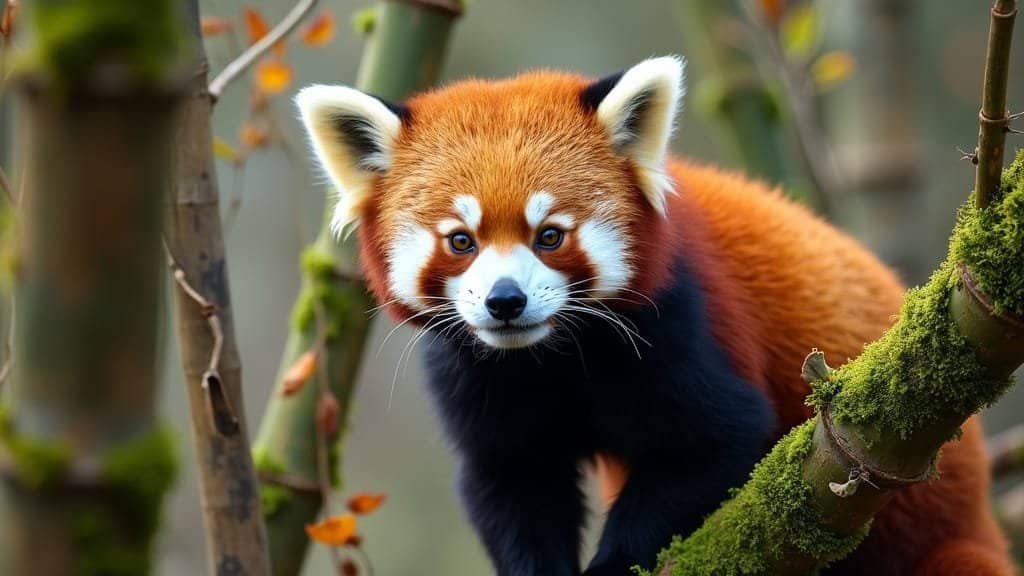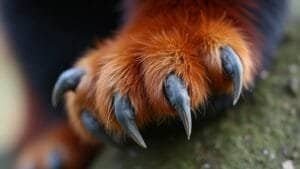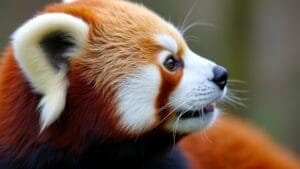The red panda’s fur color is not only striking but also a vital adaptation for its survival in the wild. Its reddish-brown coat, white facial markings, and bushy, red-and-white ringed tail help it blend seamlessly into the moss-covered trees and dappled sunlight of its Himalayan forest habitat. This natural camouflage protects the red panda from predators like snow leopards and birds of prey
Additionally, its thick, double-layered fur provides warmth in the cold, high-altitude climates it calls home. In this article, we’ll explore how the red panda’s fur color aids in camouflage, predator evasion, and temperature regulation, while also examining its evolutionary advantages and role in survival
The Unique Features of the Red Panda’s Fur
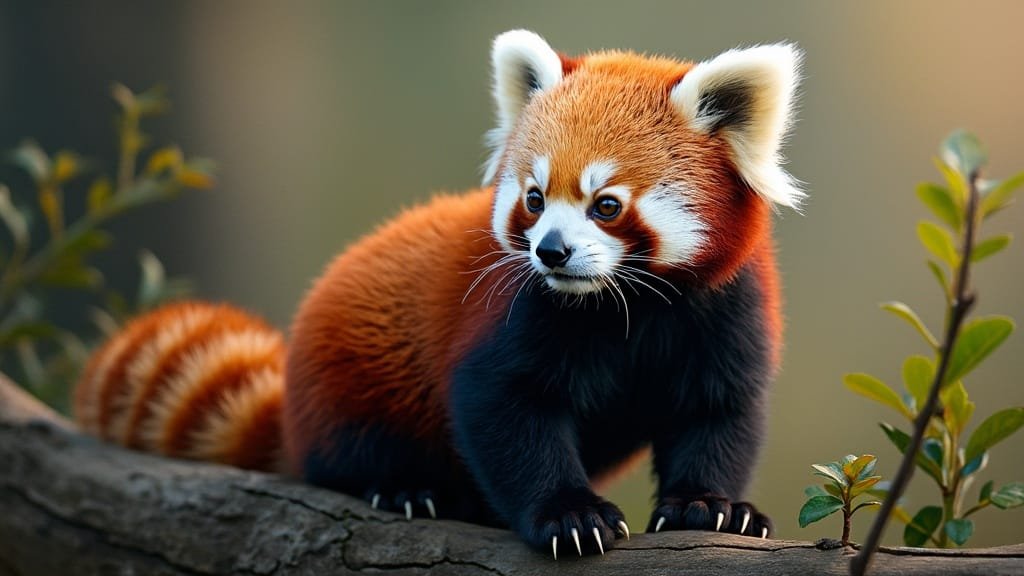
The red panda’s fur is a key adaptation that ensures its survival in the dense, high-altitude forests of the Himalayas and surrounding regions. Its coat provides both physical protection and camouflage against predators, blending seamlessly into its environment. Below, we’ll explore the specific features of the red panda’s fur and their importance for survival, with references to official studies and research
Reddish-Brown Fur and Its Role in Camouflage
The reddish-brown fur of the red panda allows it to camouflage effectively in its natural habitat. In the forests of the Himalayas, tree trunks are often covered in reddish moss and lichens, and the red panda’s fur blends into this backdrop, making it nearly invisible to predators such as snow leopards or eagles
A study by Choudhury in the Journal of Zoology (2001) confirmed that the red panda’s fur coloration disrupts its silhouette, reducing its visibility to predators. This adaptation is especially effective in the dappled sunlight of the forest canopy, where patches of light and shadow intermingle. By imitating the tones of its environment, the red panda increases its ability to remain hidden, even when predators are actively searching for prey
White Facial Markings and Countershading
The red panda’s white facial markings are not only distinctive but also functional. These markings help to break up the outline of its face, making it harder to detect from a distance. Additionally, countershading, which is common among many arboreal mammals, is another important adaptation for the red panda. The lighter fur on its face contrasts with its darker back, helping it blend into its surroundings when viewed from different angles
According to a study by Roberts and Gittleman (Mammalian Biology, 2020), countershading in red pandas minimizes visibility to both aerial and ground-based predators. These facial markings also assist with communication between individuals in low-light forest environments, particularly during the mating season, when visual signals are essential for recognition
The Tail’s Red and White Rings: A Survival Tool
The red panda’s bushy tail, adorned with alternating red and white rings, is another significant adaptation for survival. These rings mimic the way light filters through the trees, making it difficult for predators to detect the red panda as it moves through the forest canopy. A behavioral study by Yonzon et al. (Biological Conservation, 1987) noted that the tail’s patterning is especially effective when viewed from below, where predators such as snow leopards or martens might hunt
The tail also serves as an additional source of warmth during cold Himalayan winters. When resting, the red panda wraps its tail around its body to conserve heat. This behavior, documented by Pradhan et al. (Journal of Mammalogy, 2001), highlights how the tail fulfills both environmental and thermal needs in a challenging habitat
For more insights into how the red panda’s physical features contribute to its survival, you can explore this Fort Worth Zoo resource on red pandas
The Survival Benefits of the Red Panda’s Fur Color
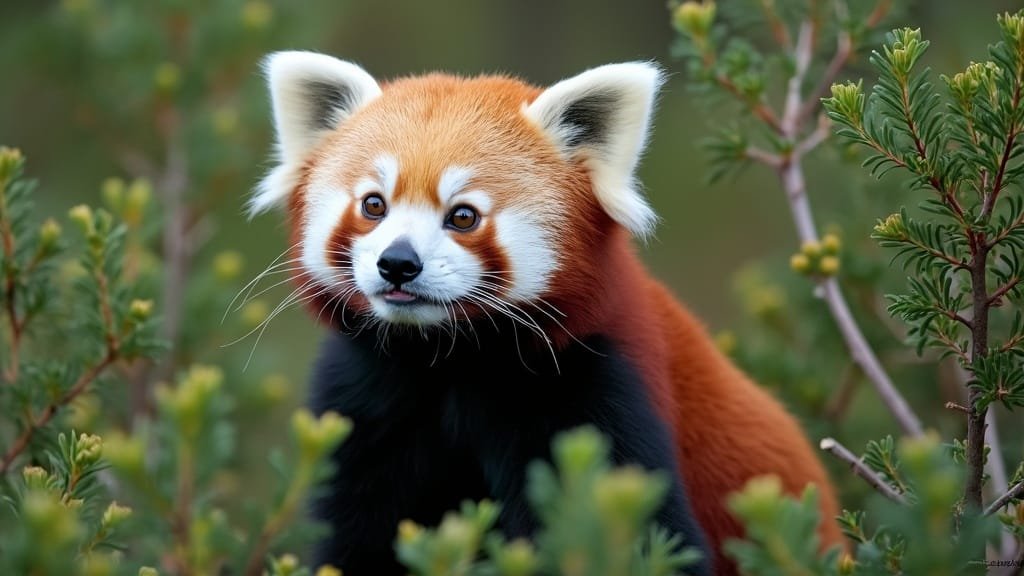
The red panda’s fur color is essential to its ability to survive in its environment. Its reddish-brown coat, white facial markings, and tail pattern all contribute to its protection against predators and the challenges of living in high-altitude forests. Below, we will examine how these features support the red panda’s camouflage, seasonal adaptation, and evolutionary success
Camouflage Against Predators
The red panda’s ability to blend into its surroundings is one of its most effective defenses against predators. Its reddish-brown fur matches the tree trunks, moss, and lichen found in the temperate forests of the Himalayas, while the white markings on its face break up its shape and make it harder to spot from a distance
A study conducted by Choudhury (Journal of Zoology, 2001) found that the red panda’s camouflage is particularly effective in forest canopies with dappled sunlight. When the red panda stays still among branches, its reddish fur and ringed tail help it disappear into the light and shadow patterns created by leaves and bark. This reduces its visibility to predators such as snow leopards, clouded leopards, and martens, which rely on sight to detect prey
In addition, the tail’s alternating red and white rings serve as camouflage from predators observing the red panda from below. As noted in a behavioral study by Yonzon et al. (Biological Conservation, 1987), these markings mimic the filtered light of the forest canopy, creating a natural disguise that is hard for predators to penetrate
Seasonal Adaptations and Environmental Blending
The effectiveness of the red panda’s fur as a camouflage is enhanced by its ability to adapt to seasonal changes in its habitat. During autumn and winter, when leaves and tree bark take on deeper red and orange tones, the red panda’s fur blends even more effectively with its surroundings. This seasonal blending ensures that the red panda remains concealed year-round, regardless of changes in its environment
Additionally, its thick fur helps it survive the freezing temperatures common in its habitat, which can range from 23°F to 77°F. The fur’s outer layer is water-resistant, protecting the red panda from wet conditions, while the dense underlayer provides insulation to conserve body heat. According to Roberts and Gittleman (Mammalian Biology, 2020), this dual-layered fur structure minimizes energy loss, which is critical for an animal that relies on a low-nutrient bamboo diet
Evolutionary Advantages of Reddish Fur
Over time, the red panda’s fur color has evolved as a specific adaptation to the unique challenges of its environment. The reddish-brown hue, while unusual in the animal kingdom, gives the red panda a distinct advantage by allowing it to remain hidden in its arboreal habitat. Predators that fail to spot the red panda are less likely to hunt it, giving camouflaged individuals a higher chance of survival and reproduction
A comparative study of arboreal mammals conducted by Wei et al. (Journal of Mammalogy, 2014) highlighted the red panda’s fur color as a product of natural selection. This study observed that individuals with more effective camouflage were better able to evade predators and survive longer, increasing the likelihood of passing on their genes. The red panda’s fur color is therefore not just an incidental trait but a critical adaptation that has ensured its survival for millions of years
For additional details on how the red panda’s fur supports its survival, you can refer to the International Fund for Animal Welfare’s red panda resource
How the Red Panda’s Fur Supports Its Arboreal Lifestyle
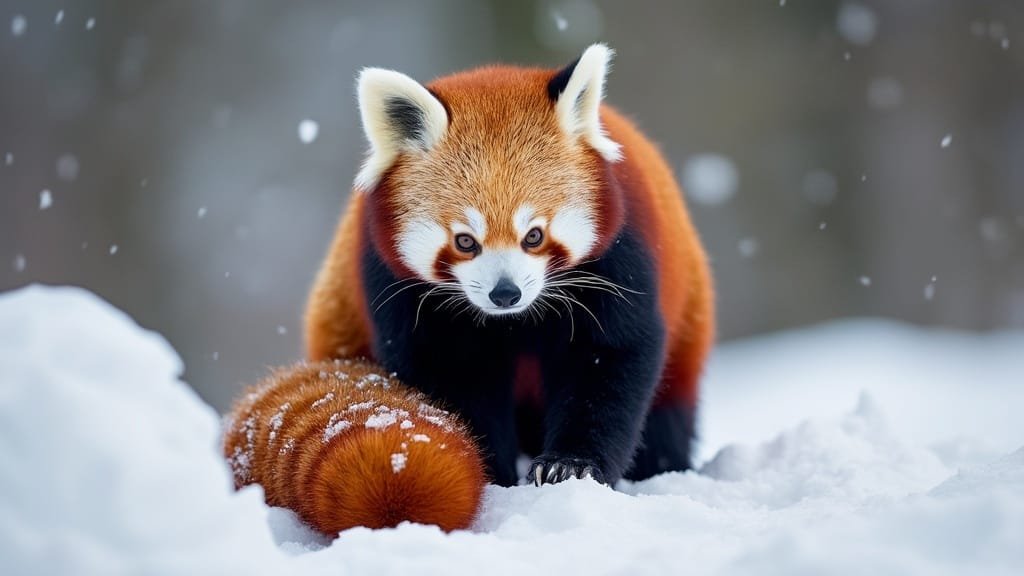
The red panda’s arboreal lifestyle requires a combination of agility, camouflage, and insulation to thrive in its high-altitude forest habitat. Its fur is perfectly adapted to support this way of life, enabling the red panda to navigate the challenges of living among the trees and surviving in cold climates
Insulation in Cold Himalayan Climates
The red panda’s thick, double-layered fur provides the insulation necessary to survive the cold temperatures of its habitat, which can drop below freezing in the Himalayan mountains. Its outer layer of long, coarse hairs acts as a water-resistant barrier, protecting the panda from snow and rain, while the dense underlayer traps heat close to the body
Research conducted by Pradhan et al. (Journal of Mammalogy, 2001) noted that red pandas’ fur insulation reduces their need to expend energy generating body heat. This adaptation is particularly valuable for an animal that relies heavily on bamboo, a low-calorie food source, to sustain its energy levels. By conserving heat efficiently, the red panda can maintain its metabolism while resting in trees during the colder months
The fur on the tail also plays a significant role in thermal regulation. When sleeping or resting, red pandas wrap their bushy tails around their bodies, creating an additional layer of warmth. This behavior, often observed in field studies, demonstrates how the red panda’s fur supports both its physical and environmental needs
Predator Avoidance Through Stillness and Concealment
Red pandas rely on their fur’s camouflage and their ability to remain motionless in the trees to avoid detection by predators. Their reddish-brown fur matches the tones of moss-covered tree trunks and branches, while the ringed pattern on their tails helps them blend into the dappled sunlight of the forest canopy
A study by Yonzon et al. (Biological Conservation, 1987) found that red pandas often freeze in place when predators such as snow leopards or martens are nearby. This behavior, combined with their effective camouflage, allows them to go unnoticed even in close proximity to danger. Predators that rely on movement or visual contrast to locate prey are less likely to detect the red panda, giving it an evolutionary advantage
The effectiveness of this strategy is particularly important for red pandas, as their small size and relatively low physical strength make them vulnerable to a wide range of predators. By staying hidden and still, the red panda avoids unnecessary risks and conserves energy for foraging and climbing
Combining Fur and Tail for Maximum Survival
The red panda’s fur and tail work together to meet the challenges of arboreal living. The tail not only provides warmth but also helps with balance as the red panda moves along narrow tree branches. Its alternating red and white rings make it difficult for predators to track its movements, while its length provides the stability needed to traverse precarious heights
The fur’s softness and flexibility allow the red panda to curl into tight spaces for shelter, such as tree hollows or rocky crevices. According to Roberts and Gittleman (Mammalian Biology, 2020), this behavior protects the red panda from harsh weather and predation, giving it a safe place to rest during the day. These combined features allow the red panda to thrive in an environment where many larger animals struggle to survive
For further insights into how the red panda’s fur adaptations contribute to its arboreal lifestyle, you can explore the Red Panda Network’s article on red panda facts
